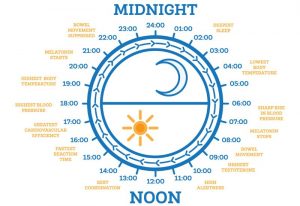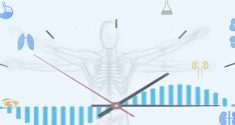While concepts associated with chronobiology have been with us for centuries, it is only with modern science that we’ve been able to truly see how biological rhythms come into play on a molecular level. As science is able to delve deeper into the study of biological rhythms and the significance of their timing, a wealth of new knowledge is opening up exciting potentials for the treatment of disease and the protection of health. Among these new potentials is the role of chronopharmacology and chronotherapeutics in optimizing drug treatment benefits and helping to reduce harmful side effects.
Time and Rhythm Run Deep
 The prefix chrono- comes from a Greek word, khronos, meaning time. Rhythms are all about time and timing, and they can run deep. Perhaps the rhythm that runs deepest is that of day and night, the approximately 24-hour rhythm of life that humans evolved to. That circadian rhythm and the human behaviors it influenced, such as being active during the day and resting at night, became entwined with the mechanics of how our bodies run, serving as an organizing factor, even for the activities of each single cell.
The prefix chrono- comes from a Greek word, khronos, meaning time. Rhythms are all about time and timing, and they can run deep. Perhaps the rhythm that runs deepest is that of day and night, the approximately 24-hour rhythm of life that humans evolved to. That circadian rhythm and the human behaviors it influenced, such as being active during the day and resting at night, became entwined with the mechanics of how our bodies run, serving as an organizing factor, even for the activities of each single cell.
Chronobiology studies biological rhythms. Chronopharmacology, then, refers to the interaction between biological rhythms and medications. Chronotherapeutics is the practical application of chronopharmacology principles with a goal of timing medications with consideration of biological rhythms for maximum benefit while reducing potential negative side effects.
Exploring the Role of Chronopharmacology in Medicine
Understanding the role of chronopharmacology first necessitates an explanation of circadian rhythms. Circadian rhythms influence countless processes within the body, including those related to how drugs are absorbed and metabolized by the body and, eventually, eliminated from the body. For example, there may be a peak time of day at which the proteins needed for a drug to be absorbed by the body are most available. Time of day can play a real role in how effective a medication is and can influence the balance between benefit and toxicity. These concepts regarding the timing of medicine for optimal benefit and reduced negative side effects are not new. In fact, medical science has been exploring chronopharmacology concepts for decades.
However, human biological rhythms aren’t the only rhythms to consider in a medical situation. The parasite that causes malaria, for example, with its cyclic fevers, has its own circadian rhythm, as does the parasite that causes sleeping sickness. Many pathogens have their own circadian rhythms, as do certain types of cancer cells. Modern chronopharmacology and chronotherapeutics are evolving to be able to better accommodate the potential for there to be multiple rhythms at play when determining the most advantageous timing in devising a drug treatment plan.
Cancer, Cardiovascular Disease Research and Chronopharmacology
Cancer and cardiovascular disease, two of the leading causes of death, played an important role in the development of modern psychopharmacology. These two disease areas saw some of the earliest chronotherapeutics successes.
The timing of cancer medications was shown to influence the efficiency of the drugs and their toxicity in clinical testing. Today, medical researchers are also able to take into consideration and target the varying circadian rhythm of cancer cells for even more accurate timing of medication.
For cardiovascular diseases, researchers found that cardiac events, such as stroke, angina and heart attack, seem to be influenced by a circadian rhythm, being more likely to occur in the morning. That led researchers to work with the timing of medications with a goal of providing the necessary medicinal support at the correct time to avoid major cardiac events.
Drug Timing and Other Diseases and Health Conditions
Rheumatoid arthritis is an autoimmune disease that recent research has found may benefit from a chronotherapeutics approach. By adjusting the timing of medications, most commonly non-steroidal anti-inflammatory drugs (NSAIDs) such as aspirin, naproxen and ibuprofen, and the immunosuppressive methotrexate, those medicines can be at peak effectiveness in the morning, when symptoms are typically at their worst.
Asthma, more likely to produce more severe symptoms at night, and allergies have also been shown to benefit from drug timing. The chronotherapeutics approach is also a highly valuable tool in the management of diabetes. Researchers are also studying the potential impact of chronopharmacology on treating sleep disorders and depression with encouraging results.
Targeted, Safer and More Effective Treatment

The role of chronopharmacology in opening up new potentials will help to reduce the risk of harm while maximizing drug efficacy. And, as always, scientists are reaching even further, seeking ways to target the biological rhythms of pathogens, parasites and diseased cells while working with the circadian rhythms of the individual patient to produce drug treatment plans that are more tightly targeted, safer and more effective.







